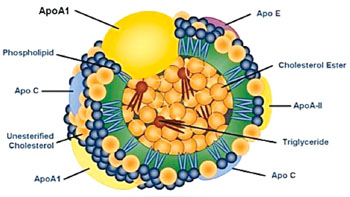Cardiovascular Risk Predicted by Test Measuring HDL Proteins
By LabMedica International staff writers
Posted on 10 Dec 2014
A new laboratory test has been developed that measures the presence of certain proteins in the High-Density Lipoprotein complex that can lead to an increased risk of cardiovascular disease and mortality.Posted on 10 Dec 2014
High-Density Lipoprotein (HDL) is a class of proteins that plays a key role in the body's metabolism of cholesterol and HDL causes the cholesterol to be transported to the liver, where it is broken down and this gives rise to the popular name for HDL of “good cholesterol.” HDL is made up of only around 20% cholesterol and over 50% of HDL is made up of different proteins.

Image: The composition of High-Density Lipoprotein Cholesterol (Photo courtesy of the University of California Davis).
Scientists at the Medical University of Vienna (Austria) measured the concentrations of HDL-associated serum amyloid A (SAA) and surfactant protein B (SP-B) in 1,152 patients with type 2 diabetes mellitus on hemodialysis participating in The German Diabetes Dialysis Study who were randomly assigned to double-blind treatment of 20 mg atorvastatin daily or matching placebo. The association of SAA (HDL) and SP-B (HDL) with cardiovascular outcomes was assessed in multivariate regression models adjusted for known clinical risk factors.
High levels of SAA in the HDL were associated with an increased occurrence of heart attacks, while high levels of SP-B in the HDL acted as a marker for a generally increased risk of mortality. This discovery could change the evaluation of HDL. Clinical practice currently only measures the amount of cholesterol in the HDL (known as the HDL-C) and from which the protective effect against future cardiovascular disease is derived. This relationship may hold true for the healthy population. More recent studies have shown, however, that in many chronic diseases such as coronary heart disease, diabetes mellitus or in patients receiving dialysis, the quantity of HDL-C in the blood cannot be used as a prognostic marker.
The authors concluded that the HDL-C value continues to remain important, however the new test will also in future allow a much more precise risk prediction for cardiovascular diseases, allowing therapy to be commenced much earlier, for example through a modified lifestyle, in order to decisively improve the overall prognosis. In patients with diabetes on hemodialysis, SAA (HDL) and SP-B (HDL) were related to cardiac events and all-cause mortality, respectively, and they were independent of HDL cholesterol. The study was published in the November 2014 issue of the Clinical Journal of the American Society of Nephrology.
Related Links:
Medical University of Vienna








 (3) (1).png)





